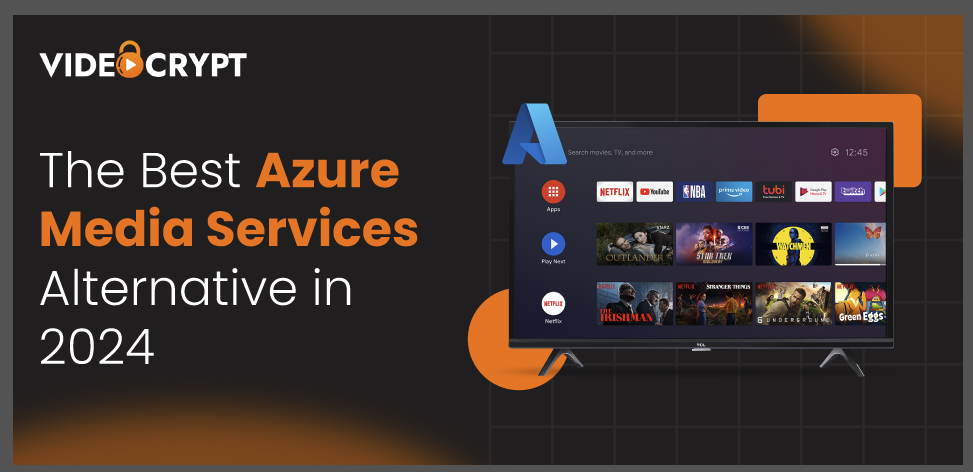Microsoft’s decision to retire Azure Media Services on June 30, 2024, has unsettled many businesses in the media and entertainment industry. These businesses are constantly seeking the best alternative to Azure Media Services for migrating their workloads and ensuring flawless operations.
This has created a lot of problems for the customers of Azure’s media service, as their media service accounts won’t be accessible after June 30, 2024. Customers will also face this disruption in allowing their audience to watch video content due to the retirement of Azure Media Player.
So let’s know what are Azure Media Services and how its retirement is going to impact customers.
Table of Contents
ToggleWhat is Azure Media Services?
Based on Cloud, Azure Media Services, or AMS is a media processing platform that enables streaming businesses to build and deploy systems to attain broadcast-quality video streaming. For the purpose of using these services, streaming businesses can design and implement various media workflows in the cloud, making it easier to upload and stream videos at scale.
Here are a few of the primary services that will retire with AMS.
- On-demand Encoding: Businesses can leverage it to efficiently convert media files from one format to another. Primarily, its purpose is to reduce the size of media and change its format to suit various device types.
- Live Streaming: Businesses can stream live events and concerts through live videos using Azure’s live streaming service. Undeniably, these businesses can stream in MPEG DASH, HLS, and Smooth Streaming Formats.
- On-demand Streaming: Businesses can use AMS to stream videos on demand. Unlike live streams, video viewers don’t need to stick to a particular schedule to watch a video.
- Content Protection Workflow: Businesses can keep their media content secured through a wide range of security measures. These measures significantly use PlayReady, Widevine, and FairPlay DRM to maintain the highest level of content security.
Now, let’s know why AMS is stopping its services by the end of June 2024.
Why AMS is Retiring?
As per the official announcement, AMS will retire on June 30, 2024, leaving its customers concerned about their future operations. Its retirement is the result of various reasons that are listed below.
- Firstly, these services don’t perform as per expectations to drive revenue for Microsoft.
- Secondly, the lack of an aggressive marketing strategy for media services could be one of the reasons for its downfall.
- Better offering by competitors like VideoCrypt for the media and entertainment industry.
- Finally, Microsoft has reassessed its media strategy and doesn’t determine AMS as the core component.
How the AMS Retirement Will Impact Customers?
According to Azure, after June 30, 2024, its customers won’t be able to access and use the Azure Media Services. However, its customers can easily store on the customer’s Azure store account and will remain unaffected by the retirement of AMS. However, all data of the account like streaming endpoints and live events, will perish due to the retirement process. So users should look for an alternative and migrate ASAP to avoid service disruption.
The bigger question now is where businesses can migrate to prevent service disruptions. The straightforward answer is to migrate to the AWS Cloud and utilize its comprehensive suite of Media Services.

AWS Media Services – Best Azure Media Services Alternative
As one of the best alternatives to Azure Media Services or AMS, AWS Media Services can help businesses drive growth and success. With these services, streaming businesses can create digital content and build live and on-demand video workflows.
This eliminates the headache of managing physical infrastructure and helps you focus on creating and delivering innovative experiences to customers. These media services are built on the most secure global infrastructure. Also, they enable businesses to reliably scale to meet the requirements of your audience size.
Here are several key AWS Media Services that can serve as alternatives to AMS following its retirement.
- Amazon IVS: Stream interactive live videos worldwide with a managed live streaming solution. It enables content creators to stream at low latency. Additionally, it allows them to provide engaging video-viewing experiences.
- Amazon CloudFront: Cache video content closest to edge locations of your audience to deliver content quickly. Deliver content at a high transfer speed using 600+ Points of Presence (PoPs).
- Amazon S3: Retrieve any amount of data anytime with this public cloud storage. Moreover, it enables users to store and secure important data on the cloud. It has a design to ensure 99.999999999% (11 9’s) of durability and help users store their data irrespective of their location.
- AWS Elemental MediaTailor: Monetize your OTT channels with the help of personalized ads. It is linear channel assembly which is also useful for inserting ads dynamically according to user’s preferences and demographics.
- AWS Elemental MediaConvert: Process your media files and prepare them for the on-demand delivery of video content. Also, generates high-quality videos using QVBR without any requirement for human intervention.
- AWS Elemental MediaLive: Create high-quality streams according to the user’s requirement. With MediaLive, businesses can deploy live channels within minutes. Moreover, it supports media communication protocols like RTMP, HLS, etc.
- AWS Elemental MediaPackage: Automatically manage resources across various Availability Zones (AZ). Certainly, this service helps to secure premium videos using the just-in-time (JIT) content security method.
And Guess what? You don’t need to pay any upfront fee. AWS Media Services follows a pay-as-you-go pricing model. Coupled with this, businesses only need to pay as per their usage.
Azure Media Services will retire soon, but don’t worry you can migrate to AWS and prevent disruption to your workloads.
Which is the Best Provider of AWS Media Services?
VideoCrypt, which provides a differentiated video streaming experience with Gen AI, is one of the best providers of AWS Media Services that can help businesses migrate their workload from AMS to AWS Cloud. It supports cloud hosting, streaming, and sharing of media content. Along with this, VideoCrypt helps businesses with:
- Live Streaming: Enable businesses to stream high-quality live videos with zero buffering and real-time video analytics. This advanced live streaming platform enables businesses to stream live videos with 99.99% uptime. Additionally, it helps businesses stream videos and deliver a high live video-viewing experience.
- Video on Demand: Leverage complete control over the video playback of the pre-recorded videos. This white-label platform provides easy customization and supports various media streaming formats, including MP4, MPEG-DASH, H.264, & H.265.
- Video Hosting: Securely store and manage media content online at affordable pricing. It enables businesses to save on revenue loss with in-built security. Also, it helps businesses to upload videos in bulk with full security through password protection and malware detection.
- Multi-DRM Security: Protect your media files from unauthorized access and illegal downloads with multi-DRM security. Also, secure your content with access control and licensing to unlock revenue potential.
- Amazon CloudFront: Deliver your media content worldwide to audiences with Amazon CloudFront – a global CDN. Certainly, it helps businesses automatically scale media workloads to handle infinite requests. It helps you deliver data through more than 600 Points of Presence, or PoPs.
- Amazon IVS: Stream engaging video in 1080p or UHD quality at low latency (2 to 3 seconds). It significantly helps to engage potential audiences through an interactive live streaming experience. Audiences also get a lean-forward video-viewing experience with collaborative live streaming experience and live chat.
Take advantage of VideoCrypt’s expertise to transfer your media workloads from AMS to AWS Media Services.
Here are the standout features of VideoCrypt, a Gen AI-powered video streaming platform.
- Seamless Live to VOD conversion with reduced bandwidth costs.
- 30% more efficient transcoding without compromising video quality.
- Dedicated on-call assistance with multi-lingual support is available.
- Enhanced security with Google Widevine, Microsoft PlayReady, and Apple FairPlay DRM.
- Protect audio and video with IP whitelisting, geo-blocking, and password protection.
- Intelligent HTML5 player with SeekBar preview and speed multiplier.
- Server-side ad insertion with no buffering between program content and ad breaks.
- Flexible and scalable content delivery through a global CDN.
- Comprehensive Media Asset Management (MAM) and Digital Asset Management (DAM) Solutions.
- Organize and facilitate efficient retrieval and video playback through a Video Management System (VMS).
- Advanced video processing, billing dashboards, and real-time video analytics.
Conclusion
Wrapping it up, AWS enhances operational availability in more than 80 availability zones within 25 regions, holding a significant share of the cloud computing market with about 30%. AWS continues to outperform its competitors, making AWS Media Services the best alternative to Azure Media Services for your business. To migrate to the AWS cloud, VideoCrypt, a secure and interactive video streaming platform, is the best choice. Undoubtedly, this platform perfectly aligns with your business goals and enables you to migrate your workloads through a pay-as-you-go pricing model.
 Offer 1 month Unlimited streaming VOD & Live with VideoCrypt Mobile App For Educational institute and Youtube Creators*
Offer 1 month Unlimited streaming VOD & Live with VideoCrypt Mobile App For Educational institute and Youtube Creators*




